
table of contents
- Trees and shrubs for the sunny slope
- Ground-covering hillside shrubs for sunny locations
- From B - K
- From S - T
- Ground-covering perennials for floral slope reinforcement
- From B - F
- From S - T
- Ideas for the north slope
- Shade-compatible hillside shrubs
- From E - I
- From T - Z
- Ground-covering perennials with blossom aspect in the shade
- From A - E
- Perennials with G
If differences in height characterize the garden, the hillside planting presents a special challenge. With the right selection of trees and shrubs, you can secure a slope and plant it attractively. If the gradient is very steep, rainwater drains off quickly and gardening is tedious. Under these conditions, vigorous, easy-to-care-for plant species are in demand, which hold the soil in place with strong roots. Get inspiration from these 20 ideas for planting a steep slope.
Trees and shrubs for the sunny slope
On the slope with a southerly orientation, drought-tolerant sun worshipers take center stage. Prefer plants with a heart root system that extends its root strands both in depth and in width. Alternatively, you can use small trees that cover the ground, the creeping shoots of which are rooted in the ground and provide additional stability in the ground. For the challenging combination of sunny and steep slopes, we would like to introduce you to the best species and varieties for attractive hillside planting:
Ground-covering hillside shrubs for sunny locations
From B - K
Ground cover roses, small shrub roses (pink)
The queen of flowers is at your side with royal blooms when it comes to colorfully planting a sunny hillside. Small shrub roses come into their own where it is steep and sunny. With a richly branched root system, ground cover roses keep the soil rigorously in place. Thanks to the good-natured undemanding nature, arduous climbing sections for maintenance work are the exception. Premium varieties are the raspberry red 'Toscana', the pink 'Fairy' and the white-filled 'Sea Foam'.
- Height: 40 to 60 cm
- Spread: 40 to 60 cm
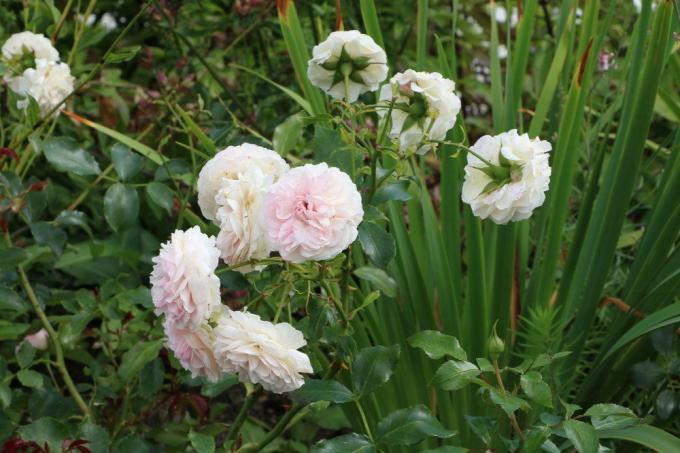
Gold ivy (Hedera helix 'Goldheart')
Equipped with strong adhesive roots, gold-ivy facades can climb to dizzying heights. Knowledgeable gardeners know how to use this vigor to fortify slopes. If gold ivy does not find any climbing aids, the rooted tendrils spread just as rapidly on the ground. However, gold ivy shows its most beautiful side wherever the framework conditions are sunny and fresh and humid. The premium variety leaves a existence in the shade to its monochrome green conspecifics. Instead, 'Goldheart' inspires with triangular decorative leaves adorned with a gold-yellow center.
- Height of growth (lying): 30 to 40 cm
- Spread: 100 to 300 cm
Creeping juniper (Juniperus horizontalis)
Creeping juniper grows slowly, tolerates blazing sun and does not have to be cut. However, so that at least one conifer is represented in the hillside planting, you cannot ignore the dwarf variety 'Repanda'. If the slope is markedly steep, spread out fabric mats before planting, which you cut in a cross shape at the planting points. While creeping juniper and its neighbors establish themselves in the soil, the tissue dissolves automatically.
- Height: 30 to 50 cm
- Spread: 200 to 250 cm
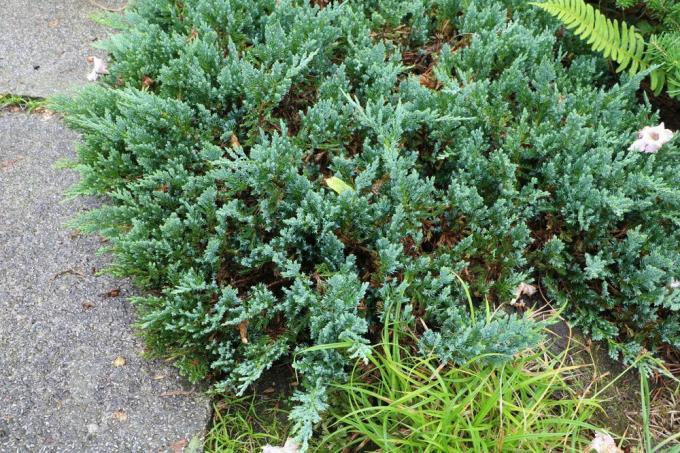
From S - T
Scarlet field thyme (Thymus serpyllum)
In the sun-drenched rock garden, field thyme proves its floral skills for sunny and dry site conditions. Reason enough to also integrate the evergreen ground cover into the planting plan. When the scarlet, fragrant flowers come into focus from June to August and in autumn that Foliage enchants with a reddish shimmer, slope gardeners know that they have done everything right to have.
- Height: 5 to 7 cm
- Spread: 20 to 25 cm
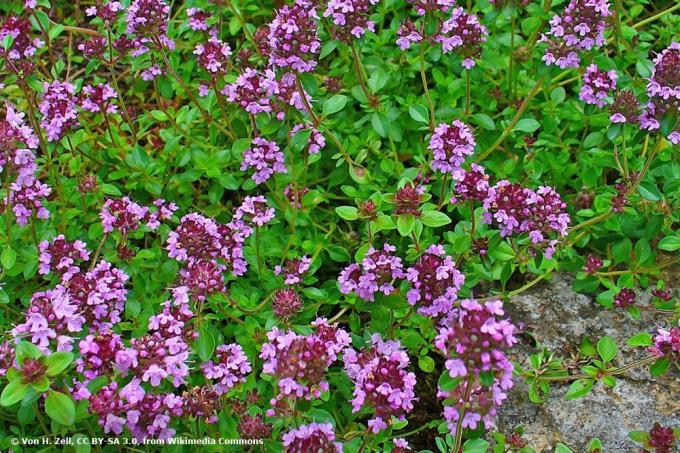
Carpet St. John's Wort (Hypericum calycinum)
The deciduous shrub made it into this selection because it is endowed with a special growth characteristic. Parallel to the above-ground, carpet-forming growth, the plant also spreads underground runners. This creates effective prevention against erosion in two respects. The carpet of St. John's wort is beautiful to look at with its bluish shimmering leaves that linger on the bush in mild winter until spring. The decorative highlight are the golden-yellow bowl flowers, which give a hillside planting a friendly face.
- Height: 20 to 30 cm
- Flowering period: from July to September

Ground-covering perennials for floral slope reinforcement
From B - F
Blue pillow (Aubrieta cultorum)
If you plant a hillside with blue pillows, a sea of violet-blue flowers will expand in spring. The most famous variety goes by the name of 'Hamburger Stadtpark'. Combine the perennial with its white-flowering conspecific 'Winterberg', the two beauties contrast impressively. The pruning is limited to pruning after the flowering period. Blue pillows love the security of stones that radiate stored solar heat on cool nights. If you arrange a few stones in the middle of the plants, the measure makes a supplementary contribution to the slope reinforcement.
- Height: 5 to 10 cm
- Spread: 25 to 30 cm
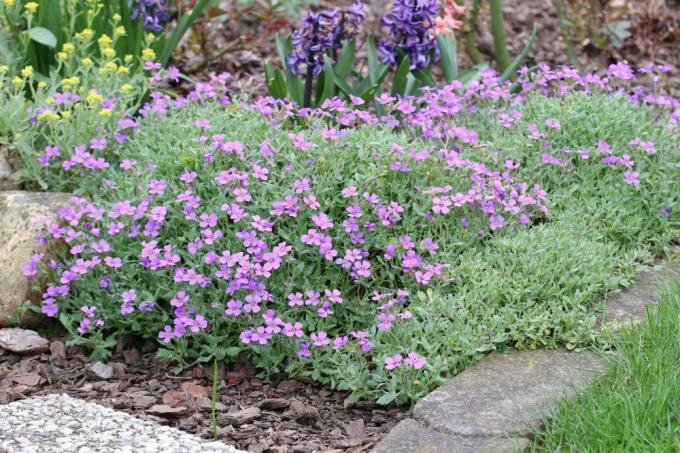
Lady's mantle (Alchemilla mollis)
If you are primarily aiming for a quick greening with the slope planting, you should plant the slope with lady's mantle. Because the evergreen perennial convinces with powerful growth, decorative pillow shape and pretty flowers in summer. Lady's mantle is perfect for slopes facing west or east. Since the finely hairy leaves evaporate plenty of moisture, a partially shaded location is recommended, which keeps the summer watering within acceptable limits.
- Height: 30 to 40 cm
- Spread: 40 to 50 cm

From S - T
Star moss (Sagina subulata)
Are you on the lookout for a firm hillside planting for the sunny to partially shaded location? Then we would like to recommend robust star moss to you. Contrary to the German name, it is not moss, but fattening herb. With its creeping, carpet-like growth, the hard-wearing ground cover plants any slope that is not too steep. Sternmoos recommends a vehement urge to spread, however, primarily for the greening of large areas.
- Height: 3 to 5 cm
- Spread: 20 to 25 cm

Gray cranesbill, ash gray cranesbill (Geranium cinereum)
Geraniums are a familiar sight to us in the summer shrub bed. You do not have to do without the long-lasting bloom in the hillside garden with south, west or east orientation. Because the gray cranesbill is perfect for the sunny and dry site conditions. The 'Purpureum' variety creates a purple-red flower dress in summer, which harmonises wonderfully with the rounded, incised leaves. Since the perennial has an aversion to waterlogging and winter wetness, it feels in good hands wherever the area is so steep that rainwater drains off quickly.
- Height: 10 to 15 cm
- Spread: 15 to 20 cm
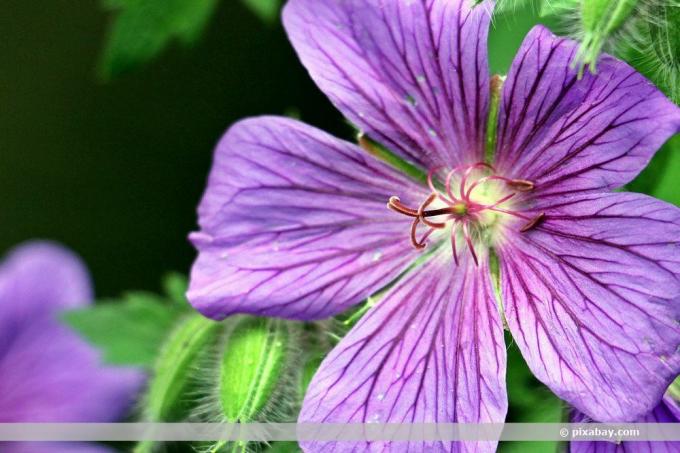
Carpet Flame Flower (Phlox subulata)
With a firework of colors, the carpet flame flower heralds spring on the sunny slope. For the rest of the year, needle-shaped leaves on long tendrils decorate the slope. There is no risk of daring climbing for maintenance work, because the perennial does not need pruning in order to bloom anew every year.
- Height: 5 to 10 cm
- Spread: 25 to 30 m

Ideas for the north slope
Shade-compatible hillside shrubs
The slope planting with north orientation will be a successful project if you make your choice among shade-tolerant small shrubs with ground cover qualities. In order to be suitable for the greening of a slope, the dwarf trees should form long but strong runners with roots on the ground. The focus is also on plant species that grow opaque over the soil without pruning. The following overview summarizes the five best species and varieties for the northern slope:
From E - I
Ivy (Hedera helix 'Woerner'),
- ideal for cool, damp, large slopes in the shade
- 20-30 cm high and 400-600 cm wide

Periwinkle (Vinca)
- Problem solver for slopes with sandy-loamy soil
- 20-30 cm high and 25-60 cm wide

From T - Z
Red carpet berry (Gaultheria procumbens)
- evergreen
- bright red berry decorations
- 10-20 cm high and 30-40 cm wide
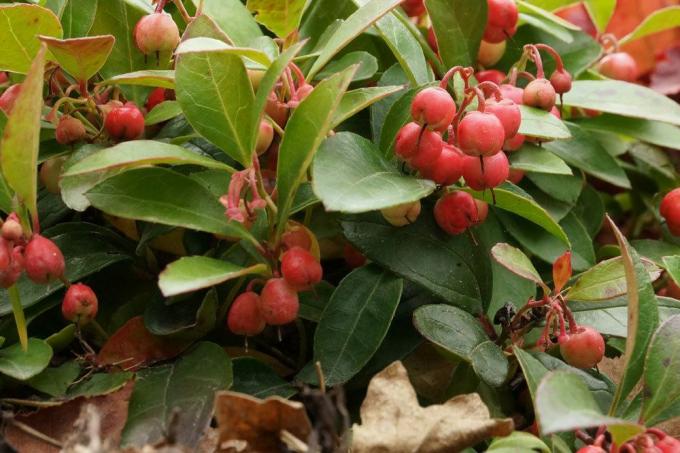
Shade green (Pachysandra terminalis)
- lives up to its name on the northern slope
- 8-12 cm high and 30-40 cm wide
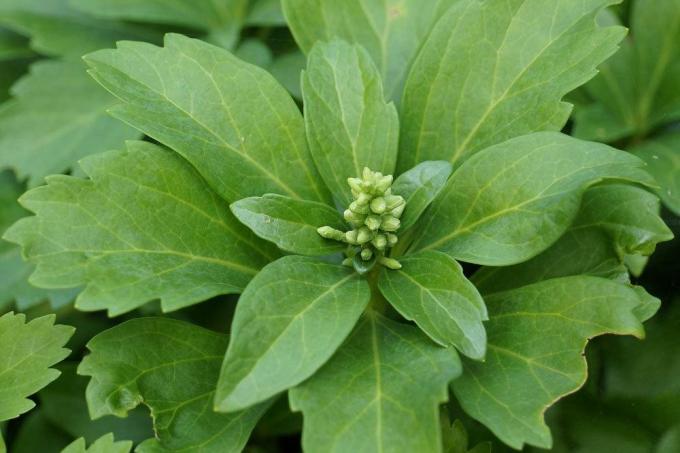
Cotoneaster, cotoneaster
- evergreen, robust and easy to care for
- 10-15 cm high and 50-70 cm wide

Our tip: Do not plant just one type of shrub on the slope. By combining your favorites with each other, you can skillfully prevent a uniform appearance. If you then place one or the other of the following shade-blooming perennials in between, the planting plan for the northern slope will turn out to be a brilliant design achievement.
Ground-covering perennials with blossom aspect in the shade
When a hillside blooms colorfully in the shade, the following perennials celebrate their floral art. As is characteristic of perennials, the plants retreat into their root ball for the winter time and then sprout freshly in the next spring. You can avoid the resulting gaps with a careful selection of plants. Plant your hillside garden with evergreen shade bloomers, because the foliage change takes place almost unnoticed here in spring.
From A - E
Stolonifera (phlox stolonifera)
- blooms in deep pink from April to June
- 20-30 cm high and 30-40 cm wide

Mountain forest cranesbill (Geranium nodosum)
- long flowering period from May to August
- 20-30 cm high and 25-35 cm wide
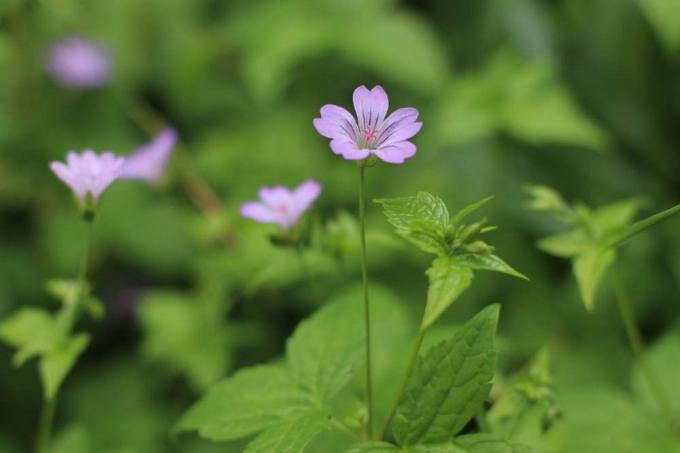
Elven flower (Epimedium)
- with delicate spring blossoms and evergreen foliage
- 20-35 cm high and just as wide
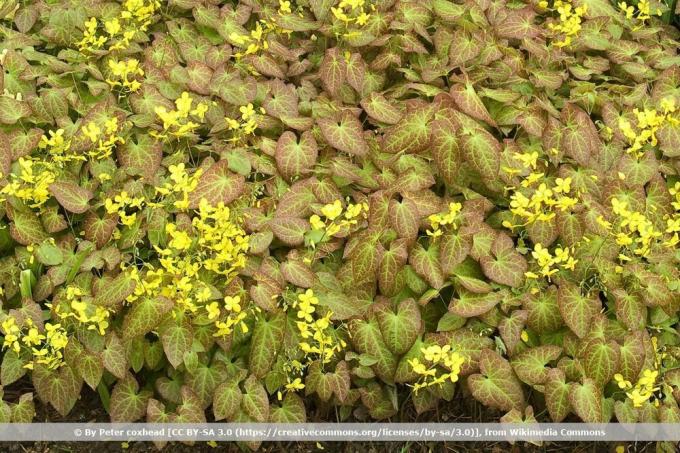
Perennials with G
Commemorative (Omphalodes verna)
- with sky-blue spring blossoms
- 8-12 cm high and 20-25 cm wide
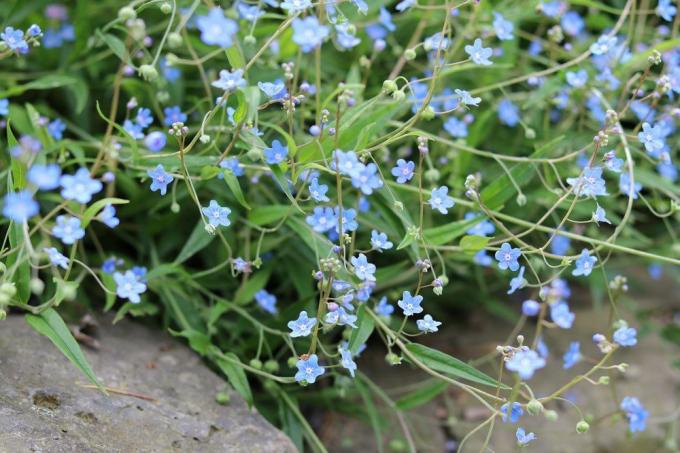
Golden nettle (Lamiastrum galeobdolon)
- blooms from May to June
- bears evergreen foliage
- 20-30 cm high and wide
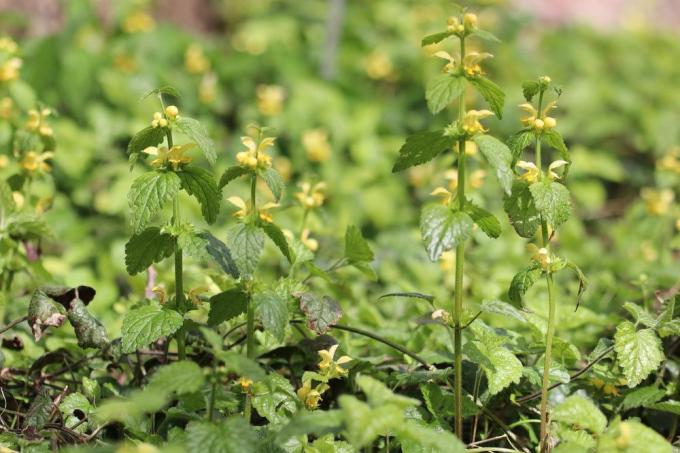
The particular advantage in the light-poor hillside garden is a sufficient supply of moisture. However, where the sun rarely shines, rainwater and morning dew can only evaporate slowly. Furthermore, the soil is so rich in nutrients that an organic start-up fertilizer covers the need. If you spread a layer of bark mulch after planting, the soil is protected from erosion right from the start. The decomposition process in the mulch also releases valuable nutrients that promote growth. You can remove the laborious climbing for a pruning from the maintenance program, because the drawn-in parts of the plant gradually decompose.



